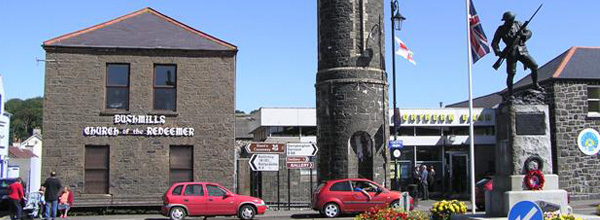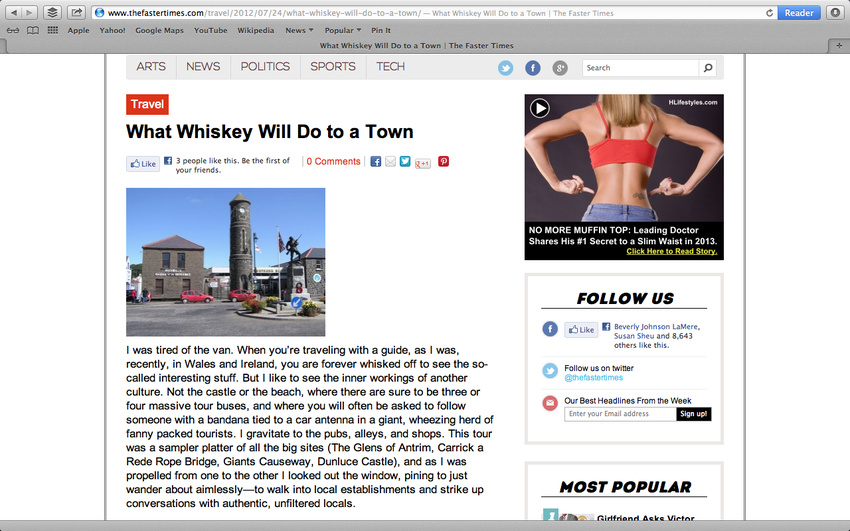What Whiskey Will Do to a Town

I was tired of the van. When you’re traveling with a guide, as I was, recently, in Wales and Ireland, you are forever whisked off to see the so-called interesting stuff. But I like to see the inner workings of another culture. Not the castle or the beach, where there are sure to be three or four massive tour buses, and where you will often be asked to follow someone with a bandana tied to a car antenna in a giant, wheezing herd of fanny packed tourists. I gravitate to the pubs, alleys, and shops. This tour was a sampler platter of all the big sites (The Glens of Antrim, Carrick a Rede Rope Bridge, Giants Causeway, Dunluce Castle), and as I was propelled from one to the other I looked out the window, pining to just wander about aimlessly—to walk into local establishments and strike up conversations with authentic, unfiltered locals.
The name Bushmills is recognizable for the Irish whiskey that takes its name. But it’s also a village in Northern Ireland, where I was to spend the night. When we drove down the main street of the village I saw lots of people in store windows going about their lives: mothers with children buying meat for the family dinner, men sitting at tables, watching the cars go by, no doubt telling entertaining stories. There were a couple of local pubs and several mom-and-pop-looking establishments. When we checked into the Bushmills Inn, a cozy property with peat-burning fireplaces as well as a welcoming pub and restaurant, I dumped my luggage in a vast room with a king-sized, four-poster bed and a huge bathroom with its very own lap-tub (you could have farmed salmon in it; if you filled it up it would have changed the weather). Then I took my camera and notebook, and set off for the town. It was unusual to have free time, and it was probably an oversight. The people who run tour companies seem to think that if every minute is not taken up with seeing something, their customers will somehow feel slighted. I relished the opportunity, and planned to make the most of it.
Everywhere I traveled in Ireland, the food seemed to come from some farm right down the road. Nobody bragged or made a big deal out of it because where else would food come from? I would tell local restaurant proprietors about the “Slow Food” movement in the United States, and they would look at me with amazement: they couldn’t understand why such a thing would even need to exist. So when I was staring out the van window, I developed a fantasy of interviewing some local butcher with whom I could speak about how ridiculous it is that most of the United States gets its food frozen, off the back of a truck. This would then lead to a spirited and profound discussion of family values, family business, and the importance of place. At which point he or she would then invite me to their house to make me some kind of feast.
“Which way is the butcher shop?” I asked the lady at the hotel’s reception desk.
“The town is down the driveway, through the arch, and then you take a right. But…”
“Thanks!” And I was off. I didn’t have time for prolonged chit-chat. I was on a mission to see some local culture; and I had a deadline, as I was supposed to meet my group for dinner in only an hour.
I followed the receptionist’s directions, and started walking down the street. Up to my right was the town’s only butcher shop: a family owned spot that had been in operation for several hundred years, started by a great patriarch with mischievous green eyes and a ready laugh, whose legacy had been passed down to subsequent generations through the ancient tradition of oral storytelling. At least that’s what I had hoped. But when I got up to the window I saw that the shop wasn’t real but merely a giant scanned image of a butcher shop taped to the interior of its windows. I walked next door, to the cobbler, but that storefront was also a facade. I walked up and down the street, and with the exception of a bed-and-breakfast and another pub, the entirety of the village was nothing more than a bunch of false advertising.
What the hell? Was I in Northern Ireland or on a set on the backlot of Universal Studios?
Depressed, downtrodden, and altogether disappointed, I walked with stooped shoulders back to the hotel and to the outside of the hotel’s restaurant where I slumped into a chair. A black-and-white cat, sitting on a wall, came over and jumped in my lap. He looked up at me with predatory eyes, as if to say: “Snap out of it!”
“You are real, aren’t you?” I asked the cat, who purred in response. Then he saw something more interesting somewhere, and his claws dug into my legs, and he took off like a bolt of furry lightning. I looked down to see eight little puncture wounds in my favorite travel pants.
I got up and walked into the overheated pub, which smelled of peat and oft-told family stories, walked up to the bar, and ordered a pint of Guinness.
“This whole town is fake,” I said to the bartender.
“No. Just closed,” the bartender said. He was a good bartender, I felt, both knowledgeable and chatty—yet young enough not to be a crank pot.
“It fooled me. I bonked into a fake door.”
“When the Olympic torch came through here, they didn’t think it would look good to see a bunch of empty storefronts, so they put fake ones up.”
“Well they did a good job. You really can’t tell.”
“Once you know they’re fake it’s pretty obvious.”
I didn’t say anything to that. Or maybe I grunted, or let out a harumph.
We talked about how I had just visited Giants Causeway, which sounds like something you might see in scenic East Rutherford, N.J., near Giants Stadium. In fact, it’s a collection of odd geometric basalt rock formations along the northern Irish coast that could have been booby trapped obstacles in an Indiana Jones movie (step on the wrong one, and an arrow goes through your eyeball). But these rocks leant the coast its air of mysticism. I could easily imagine Merlin and a host of Druids hexing people on the UNESCO World Heritage site, even if it now features a new, “interactive” museum.
“Sucks they built that museum there,” the bartender said. “You can’t take the rocks now. They make good stools.”
I had heard many stories from various tour guides involving Irish thievery over the last few days, and so the idea of a group of people hauling off rocks weighing hundreds or thousands of pounds almost made sense. It’s well known that the Irish, like many of the world’s historically subjugated cultures, have had a rough go of it. Pilfering for survival—along with great storytelling—seems built into their DNA.
Drinking the Guinness, talking with the chatty bartender, I started wondering what I was looking for and why. Here it was, 2012, and I was looking for an Irish village from the seventeenth century. Why should I be surprised, that just like in America, other countries are modernizing and falling prey to the false charms of progress? Small towns can suffer attrition just as much in Northern Ireland as they can in Iowa. It’s as if I was looking for some non-existent romanticized version of Northern Ireland instead of its current reality.
I might not have gotten my family butcher story. And I might not have seen the village, since it doesn’t seem to be open anymore. But I did, in the end, get a peek behind the curtain—even if it wasn’t the experience I had made up in my head—that I couldn’t have found driving in the van from one expected sight to the next. It hadn’t gone the way I’d planned it, but I’d still found what I was looking for. I took my Guinness, bid the bartender adieu, tipped him handsomely, and walked to my room, satisfied.
http://www.thefastertimes.com/travel/2012/07/24/what-whiskey-will-do-to-a-town/

